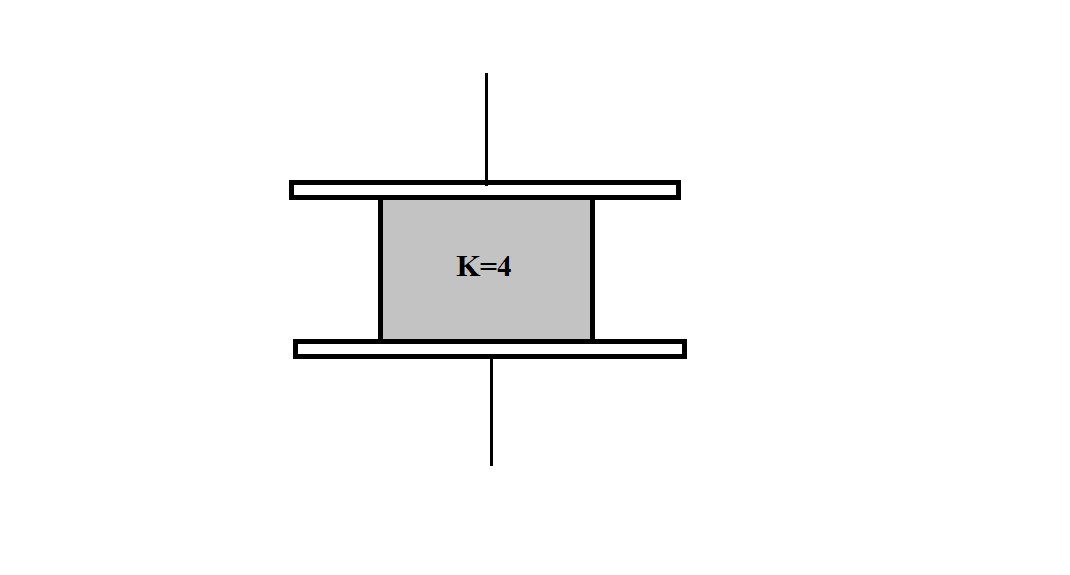
Consider a parallel plate capacitor of capacity

A.
B.
C.
D.

Answer
507.9k+ views
Hint: Dielectrics in capacitors are used to keep the conducting plates from coming in contact resulting in smaller plate separations and higher capacitance. Dielectrics increase the effective capacitance by reducing the electric field strength. We can find the final capacitance of the combination by considering it as a parallel combination of two capacitors having different values of capacitance.
Formulae used:
Complete step-by-step answer:
When a dielectric is inserted into a charged capacitor, the dielectric gets polarized by the electric field present between capacitor plates. The electric field from the dielectric will partially cancel the electric field in the capacitor plates. Adding a dielectric into a capacitor allows the capacitor to store more charge for a specified value of voltage.
The dielectric constant
For the above set of preparation, let’s take the area of capacitor plates as
For capacitors in parallel combination, the resultant capacitance is the sum of individual capacitances
Capacitance of half area of original capacitor without dielectric, being air in between the plates,
The capacitance of a capacitor having dielectric of dielectric constant
Capacitance of half area of capacitor having dielectric between its plates,
The effective capacitance of the combination is
Initial capacitance of capacitor is given as
Resultant capacitance of the combination is
Hence, the correct option is A.
Note: Students should remember the formula for resultant capacitance in series and parallel combination. The formula in case of capacitors is opposite to that of resistors.
Formulae used:
Complete step-by-step answer:
When a dielectric is inserted into a charged capacitor, the dielectric gets polarized by the electric field present between capacitor plates. The electric field from the dielectric will partially cancel the electric field in the capacitor plates. Adding a dielectric into a capacitor allows the capacitor to store more charge for a specified value of voltage.
The dielectric constant
For the above set of preparation, let’s take the area of capacitor plates as
For capacitors in parallel combination, the resultant capacitance is the sum of individual capacitances
Capacitance of half area of original capacitor without dielectric, being air in between the plates,
The capacitance of a capacitor having dielectric of dielectric constant
Capacitance of half area of capacitor having dielectric between its plates,
The effective capacitance of the combination is
Initial capacitance of capacitor is given as
Resultant capacitance of the combination is
Hence, the correct option is A.
Note: Students should remember the formula for resultant capacitance in series and parallel combination. The formula in case of capacitors is opposite to that of resistors.
Recently Updated Pages
Master Class 4 Maths: Engaging Questions & Answers for Success

Master Class 4 English: Engaging Questions & Answers for Success

Master Class 4 Science: Engaging Questions & Answers for Success

Class 4 Question and Answer - Your Ultimate Solutions Guide

Master Class 11 Economics: Engaging Questions & Answers for Success

Master Class 11 Business Studies: Engaging Questions & Answers for Success

Trending doubts
Give 10 examples of unisexual and bisexual flowers

Draw a labelled sketch of the human eye class 12 physics CBSE

Differentiate between homogeneous and heterogeneous class 12 chemistry CBSE

a Tabulate the differences in the characteristics of class 12 chemistry CBSE

Why is the cell called the structural and functional class 12 biology CBSE

Differentiate between insitu conservation and exsitu class 12 biology CBSE




